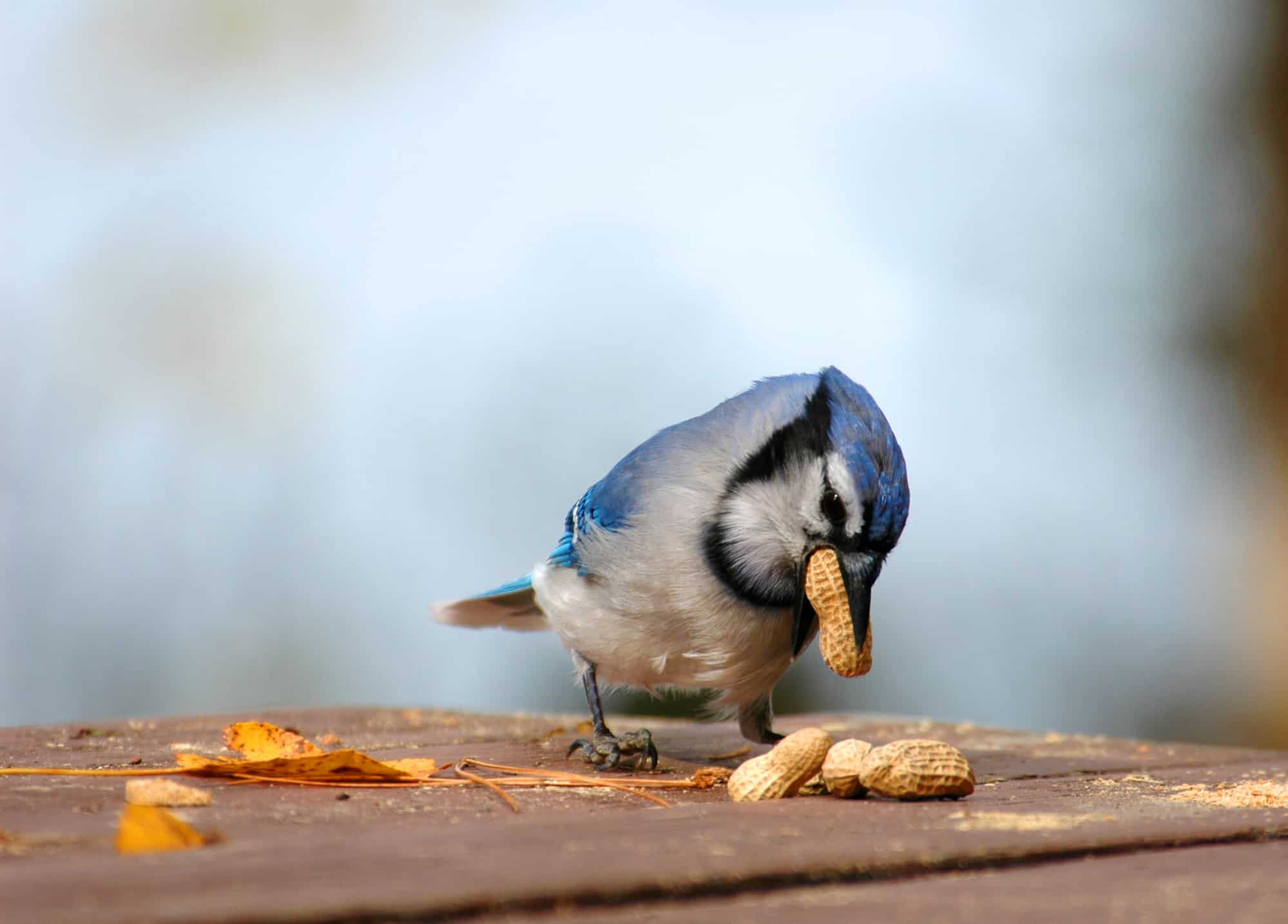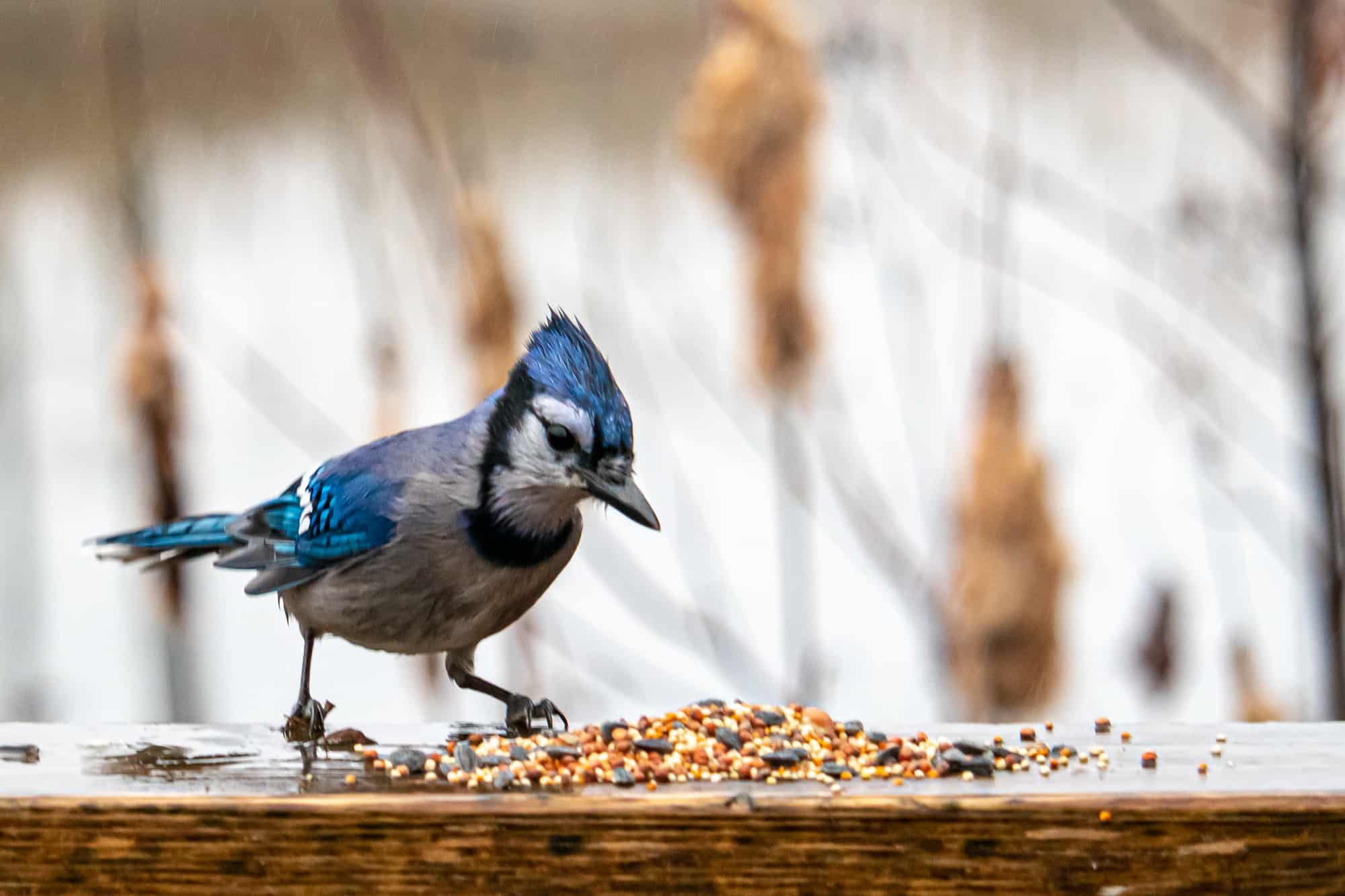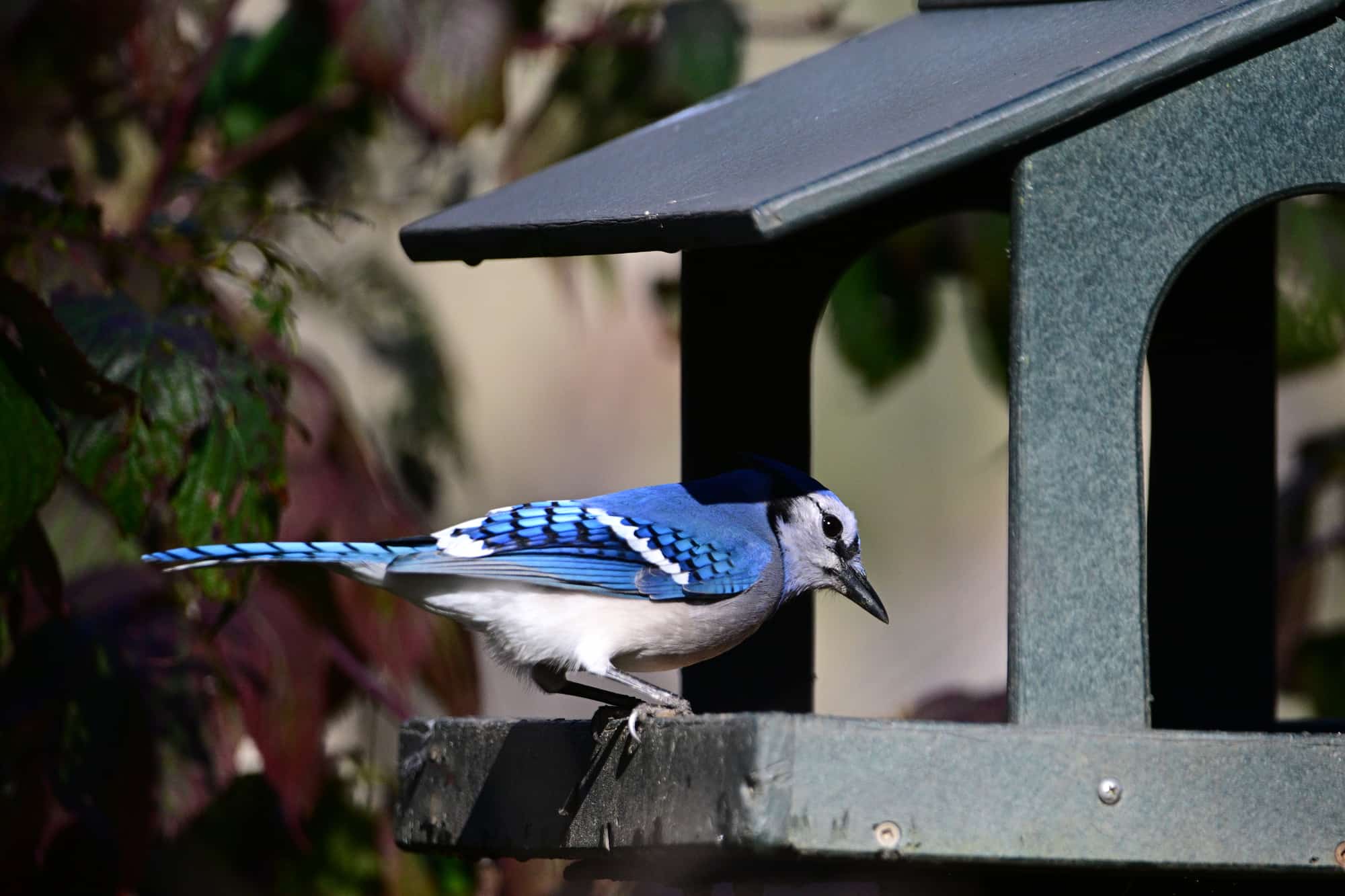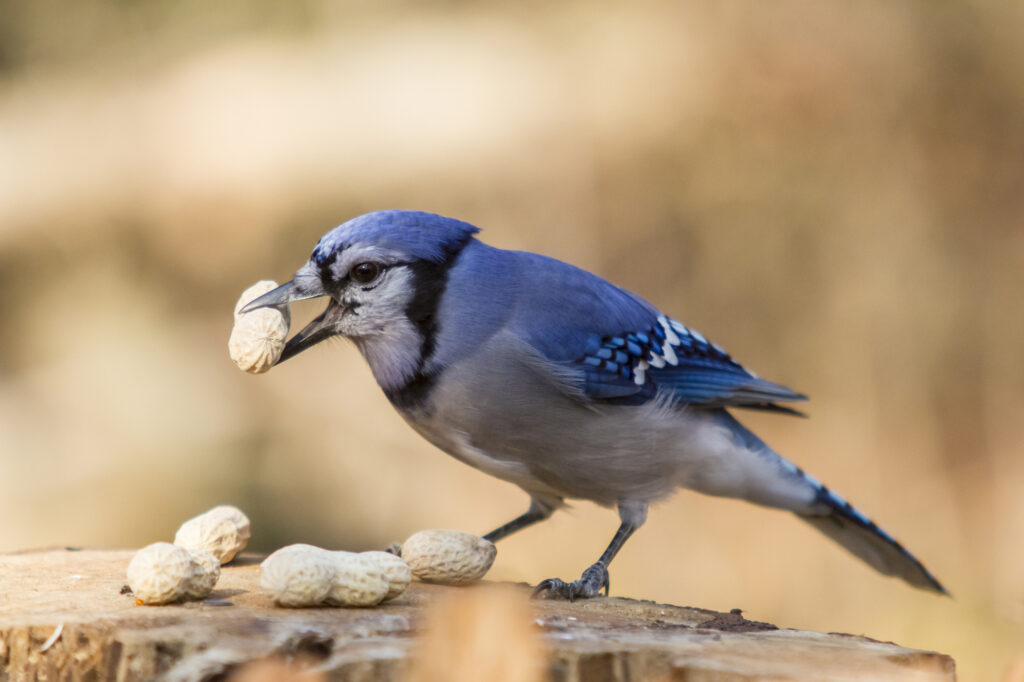Blue jays are renowned for being clever corvids, ever eager to cease upon their next snack, but which food is their favorite?
In the wild, blue jays are known to feed on fruits, insects, and even small vertebrates like deer mice, and tree frogs! Their main staple food, however, is tree nuts and seeds.
This is useful information when feeding blue jays, so you know exactly which foods will draw them into your garden! Here we’ll explore the best foods for blue jays and how you can attract more of them to your home.
Key Takeaways
- In the wild, blue jays mostly eat vegetarian food, especially nuts and seeds. They’ll also sometimes feed on invertebrates, small animals, and carrion.
- At backyard feeders, blue jays also enjoy peanuts, cracked corn, and sunflower seeds, but native foods are preferable.
- Planting nut trees, and fruit bushes, and creating a wildlife-friendly garden are excellent ways of providing food for blue jays for years to come.
What Do Blue Jays Eat in the Wild?
Blue jays are omnivorous, opportunistic feeders that naturally have a wide-ranging diet. In the wild, scientific studies have revealed they consume around 75% plant-based foods – and they especially adore nuts and seeds!
Blue jays also have a keen appetite for invertebrates such as insects and spiders, but will occasionally take larger prey, too!
The species’ natural diet will differ slightly according to where you are in North America, but the feeding habits of the Northern, Coastal, Interior, and Florida blue jay subspecies all share a lot in common.
Nuts and Seeds

Acorns are one of the very favorite food items for blue jays, but they’ll also forage greedily on beech nuts, pine nuts, hazels, pecans, chestnuts, hickories, and walnuts.
The colorful corvids will also sometimes browse fields and meadows in late summer and autumn looking for weed seeds or even grains from cereal crops.
Fruits and Berries
Fruits and berries are seasonal food items for blue jays. Fruits of native cherries, highbush cranberries, mountain ash, hawthorn, hollies, pawpaws, crab apples, serviceberries, chokeberry, and juniper all produce fruits that they’ll feed on.
They may also occasionally peck on cultivated fruits such as apples, plums, and peaches, but are not voracious fruit eaters!
Insects and Invertebrates
During the warmer months, blue jays seek out all kinds of invertebrates as a source of protein.
Caterpillars, beetles, and grasshoppers are firm favorites, but blue jays are surprisingly agile predators and can be seen catching flying insects like dragonflies on the wing. Spiders, snails, and other critters are also sometimes gobbled up by these resourceful opportunists.
Blue jays are also known for a fascinating behavior known as ‘anting’. By spreading their wings upon ants and rubbing ants on their feathers, the cunning crows drain the ants’ formic acid that they use to defend themselves. Once exhausted, the ants make a safe, plentiful meal for the jays!
Reptiles, Amphibians, Birds, and Mammals
Although not a large part of the blue jay’s diet, these members of the crow family will occasionally eat larger prey items, too.
An extensive study of blue jay stomach content revealed they’ll sometimes feed on small mice, tree frogs, lizards, and even bats! Although blue jays are often blamed for robbing eggs and nestlings from other bird species, the same study showed that this behavior is relatively rare.
Like other crows, they’ll also sometimes use their heavy bill to pick at carrion.
Stocking up for Winter
When there is a glut of food, the crafty blue jay stocks up a larder for leaner times ahead. Excess tree seeds such as acorns and beech nuts are stored in the soil to be retrieved later.
Many times, however, the jays never return to claim their stash, leaving the seeds to sprout and grow into new trees.
By leaving oak, beech, pine, and hazel seeds to grow into new trees, blue jays are ensuring future crops for their offspring to harvest (whether they know it or not!). By planting trees, they’re also making a massive contribution to the local ecosystem which benefits untold numbers of insects, birds, and mammals, not to mention microorganisms and the carbon cycles!
Whether the birds simply forget where they stored their seeds or leave them for another reason is up for debate. I lean towards the idea that the various elements of nature work together in a much more symbiotic, mutually beneficial way than is commonly thought.
The Best Foods To Give Blue Jays at Backyard Feeders
Many ornithologists believe that the very best foods to feed wild birds are those that would appear on their natural menu. By feeding blue jays acorns, beech nuts, and walnuts, you’ll be adding a healthy top-up to their native diet.

However, other nuts and seeds such as sunflower seeds, cracked corn or corn kernels, and especially peanuts appear to be relished by blue jays and make an acceptable alternative.
Fresh or dried mealworms are also readily accepted and provide a rich source of protein. Just bear in mind that insects and worms would naturally be eaten more often in the warmer months than in winter by blue jays.
Suet is another option, but please read my notes below on feeding suet safely.
Which Type of Feeder To Use for Blue Jays

Because they’re larger than many other backyard birds, blue jays require sturdy feeders to eat from. The following types are recommended:
- Large, robust hoppers
- Hanging trays
- Platform feeders
- Dishes
- Suet Cages
For further reading on the pros and cons of these different feeders, head over to our dedicated guide to the 5 Best Bird Feeders for Blue Jays, here!
Thinking about Smaller Birds
Blue jays have ravenous appetites, so can easily empty a platform feeder of seeds in a few minutes. To ensure smaller birds get their fill, remember to hang up smaller feeders in the vicinity as well!
Only Feed High-Quality Nuts and Seeds
When they’re not stored correctly, nuts and seeds can easily develop molds and fungi that produce toxins such as aflatoxin. Aflatoxin is notoriously dangerous to birds and even small amounts can prove fatal.
Always buy your bird feed from reputable sellers and take care to store it in a dry place. Monitor its quality carefully and never feed any nuts or seeds with a rancid smell or signs of mold or fungi growth.
Feeding Suet Safely

There are a couple of health issues associated with feeding wild birds, especially peanuts and suet.
Suet is one of the most popular backyard bird food items, but while it’s a rich source of calories, it needs to be fed responsibly.
When soft, suet can coat bird feathers and cause grave problems for bird insulation and egg incubation. To avoid this issue, I’d recommend only feeding suet during the colder months when it is rock-hard.
Alternative Ways To Feed Blue Jays
Plant Nut Trees
Remember how I said that a blue jay’s favorite food is nuts and seeds? To feed blue jays not just for one winter but for generations to come, plant nut-producing trees.
Oak, beech, pine, pecan, chestnut, hickory, and walnut trees are the species that blue jays rely on for staple food and these species can live for hundreds of years. On the other hand, they all grow to a large size so you’ll need a lot of land to plant them!
For smaller plots, dwarf hazels are a better option. Plant several trees to ensure adequate pollination and good crops.
Plant Berry Bushes and Fruit Trees
More suitable than nut trees for most backyard properties are berry bushes. If you don’t mind sharing a few fruits with the birds, raspberries, currants, and blueberries can provide a sweet snack for both you and your jays.
In larger plots, you could consider planting large fruiting shrubs or trees. Hawthorn, crab apple, and highbush cranberries are not only excellent for birds but have ornamental flowers and fruits, too. Serviceberries, especially the ‘Saskatoon’ type also produce delicious fruits for human consumption!
Create a Nature-Friendly Garden
As a professional wildlife gardener, I know how much creating a nature-friendly garden can help feed wild birds.
By creating wildlife ponds, planting native trees, shrubs, and flowers, leaving overgrown edges, and abandoning chemicals, you can turn your garden into a wildlife haven.
You’ll be amazed by how many more birds are attracted to feed upon the colorful, buzzing oasis of insects and wildflower seeds, and that includes blue jays!
One More Way To Attract Blue Jays – A Bird Bath or a Garden Pond

Blue jays are frequent visitors at bird baths and it’s great fun to watch them drinking, bathing, and preening.
Because they’re larger than many backyard birds, choose a bird bath with a broad basin and fill the water to 2-3 inches deep. Heated bird baths are an excellent way to provide backyard birds with easy access to fresh water throughout the year.
Alternatively, garden ponds are a fantastic way to provide fresh water and an invaluable wildlife habitat. By hosting many of the aquatic insects that blue jays love to feed on such as dragonflies and damselflies, a pond will also grow food for them!
Conclusion
When it comes to food, blue jays are resourceful opportunists that will readily feast upon most seeds, fruits, or critters that come their way! Nuts are a firm favorite on the blue jay menu and are relished both in the wild and at bird feeders.
You can find out more about feeding birds from platform feeders in our dedicated guide, here.

